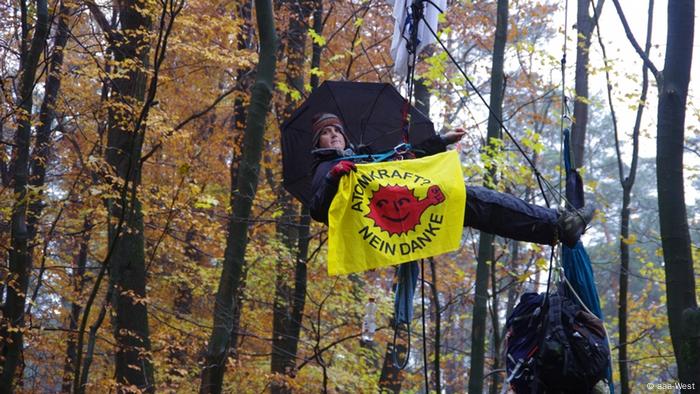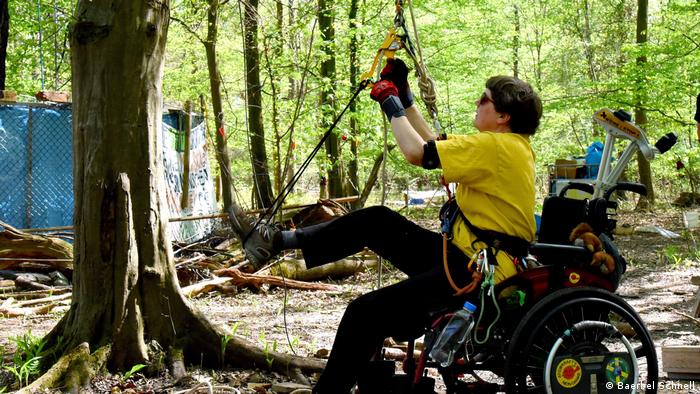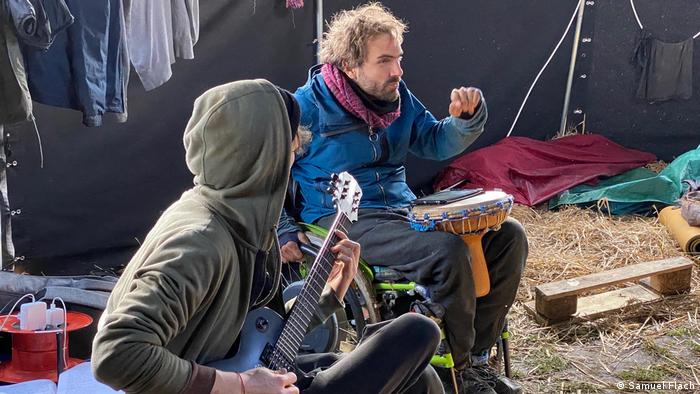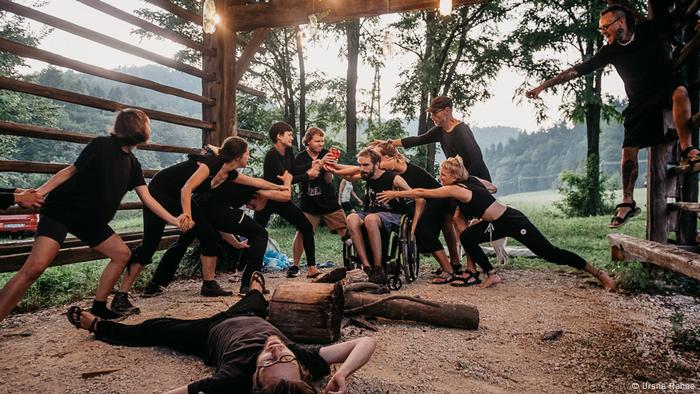GERMANY
Climate protesters with disabilities get creative
People with disabilities can be particularly vulnerable to the impacts of climate change — so why shouldn't they be at the forefront of climate activism?

Having a disability has not prevented people from becoming active in the climate protest movement
When Cecile Lecomte joined the anti-nuclear movement nearly two decades ago, she was a national climbing champion and quickly began to apply her sporting skills to environmental activism with treetop protests. But for the last three years, scaling trees has been a very different endeavor.
Lecomte lives with rheumatoid arthritis, a chronic inflammation of the joints. It's a painful, progressive disease with acute flare-ups. "This, of course, makes me see the world a little differently," she says.
These days, she must meticulously organize her life around her pain and limited mobility. "Planning is difficult because sometimes I have a phase where I'm doing well, and sometimes a phase where I can't do anything at all and need help with everything."

Cecile Lecomte aims high with her environmental activism
Getting creative
Taking part in protests now raises a host of questions: How will I get there? Will there be stairs? But the disease hasn't put a stop to her activism.
In fact, it hasn't even kept her on the ground. Lecomte can't put weight on her joints, but she can move them — when the pain isn't at its worst. So, she adapted her technique. Now, she climbs with the help of a pulley and so requires far less strength.
"I really like the challenge of climbing and seeing what I still might be able to do," she says.
At first, many doubted she would be able to maintain her climbing protests. But she was determined to prove them wrong.
"It's mind-blowing what a person can adapt to and how often that potential is not seen by society, and they say, 'You're disabled, you can't do anything,'" she says. She now shares her techniques with other environmental activists with disabilities.

Up in the treetops: For this, Lecomte has developed a special climbing technique
Fighting for inclusion
Lecomte says one reason she's been able to keep going is the close network she'd already established before she became ill — people who were committed to making their activism inclusive.
But Lecomte has had to leave some activist groups. "There was no awareness of my concerns and not much willingness to think about where there might be problems," she says, adding that the ableism manifests not only in people underestimating what a person with a disability can achieve, but also excluding them or treating them with suspicion.
Sasha Kosanic, a geographer at John Moores University in the UK who also has a physical disability, is researching the consequences of climate change for disabled people and hopes her work can help environmental activists with disabilities to advocate for inclusion.
"My aim is not only to fill in the gap in scientific research," she says, "but also to inform policymakers and activists on what should be done next in order to better understand climate change impacts on disabled populations."
Extreme weather linked to climate change can be particularly dangerous for the elderly and people with disabilities. It may be more difficult for them to evacuate, and they may not be able to access or interpret warning systems.
When western Germany was hit with lethal floods in July, 12 residents died at a care facility for those with disabilities in Sinzig near Ahrweiler because they were not evacuated in time. And this was not an isolated case. In July 2020, 14 people died in a nursing home in Kuma, Japan, during a flood because they were not evacuated, according to Human Rights Watch.
Turning 'weakness' into a strength
Leon Müller* is in his early 30s and lives in western German state of North Rhine-Westphalia. Müller has taken part in protests by Ende Gelände, a climate activist group that uses civil disobedience and occupies German coal mines. Because he draws a lot of attention as an environmental activist with an electric wheelchair and respirator, he prefers to remain anonymous.
Ende Gelände set up an inclusion task force two years ago to make its gatherings more accessible. But Müller says the police they confront often appear inadequately trained to deal with activists with disabilities.

Police are not trained to deal with environmental activists with disabilities, says Müller
One activist he has protested alongside has a disability that affects her gestures and facial expressions. "I've witnessed more than once that police are very uneasy and would prefer to talk to someone other than her," he says.
Often, officers send paramedics instead of dealing with the activists themselves — and not always with a better outcome. "Once, paramedics were on the verge of lifting me out of my wheelchair, despite the fact that I was on a ventilator," risking damage to the breathing equipment, Müller says.
But his heavy wheelchair also has advantages during blockades. "The police don't just carry off an electric wheelchair," he says. "I see to it that my supposed weaknesses can be used to our advantage."
Different platforms for different voices
For other activists with disabilities, these challenges have simply inspired more creative ways of making their voices heard.
Samuel Flach from Munich also uses a wheelchair. The 29-year-old is paraplegic and has been involved in environmental activism for some time. He's used to being in the thick of protests and confrontations with police.

With drama and drumming skills: Samuel Flach at theater rehearsals in the Dannenröder Forest
But when he came to the Dannenröder Forest occupation — where activists were camped out in the treetops in a bid to protect a tract of ancient forest threatened by a highway expansion in Hesse — he had to think outside the box.
"I can't climb trees, and physically I just can't keep up at all," he recalls thinking. "So what could I do?"
With friends, Flach founded a theater group for climate justice, using "Theater of the Oppressed," a form of interactive theater used to dissect and challenge power structures to promote political change.
They developed a play called High in the Trees, based on the Dannenröder protests. It premiered with the European theater network Resilient Revolt at a festival in Slovenia in August.

In the middle of it all as part of the troupe: Flach and fellow activists during
rehearsals at the Ne Festival in Slovenia
It was Flach's third festival, and he's noticed positive developments over the years when it comes to inclusivity. For instance, there are more wheelchair ramps on the festival grounds. He also speaks to festival organizers about his needs beforehand.
Although it was the theater group's first big performance at the festival, he wasn't nervous.
"I know a lot of people there and they know me. My wheelchair isn't really a focus anymore."
No comments:
Post a Comment